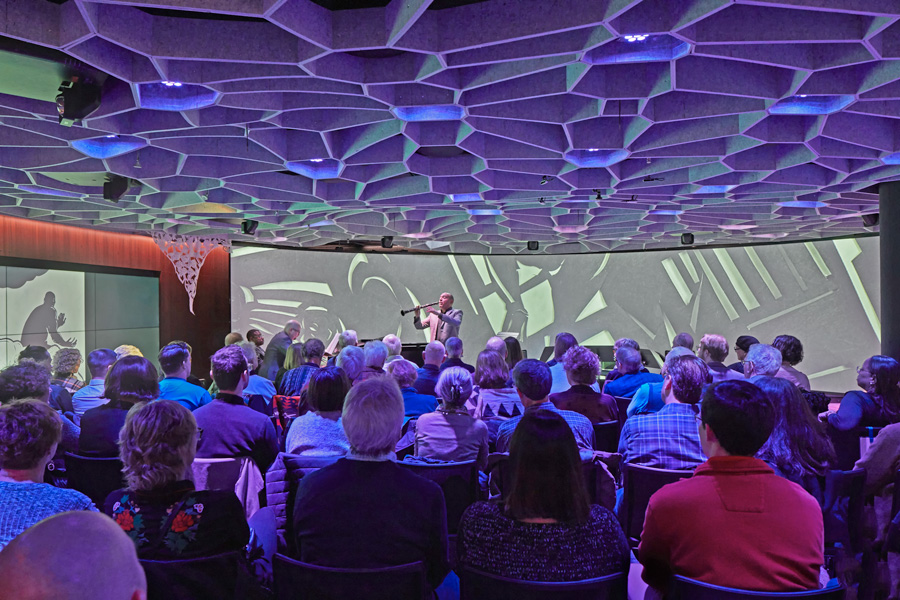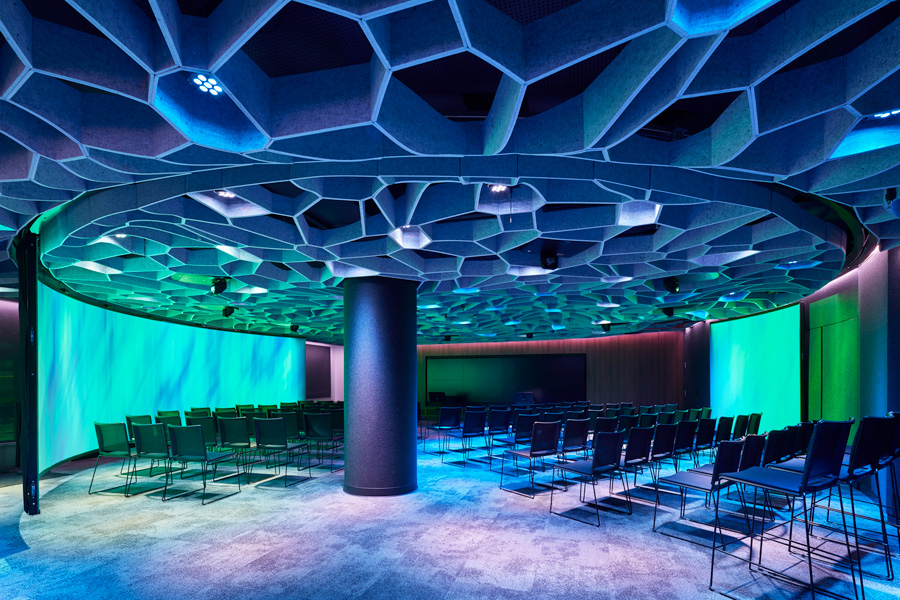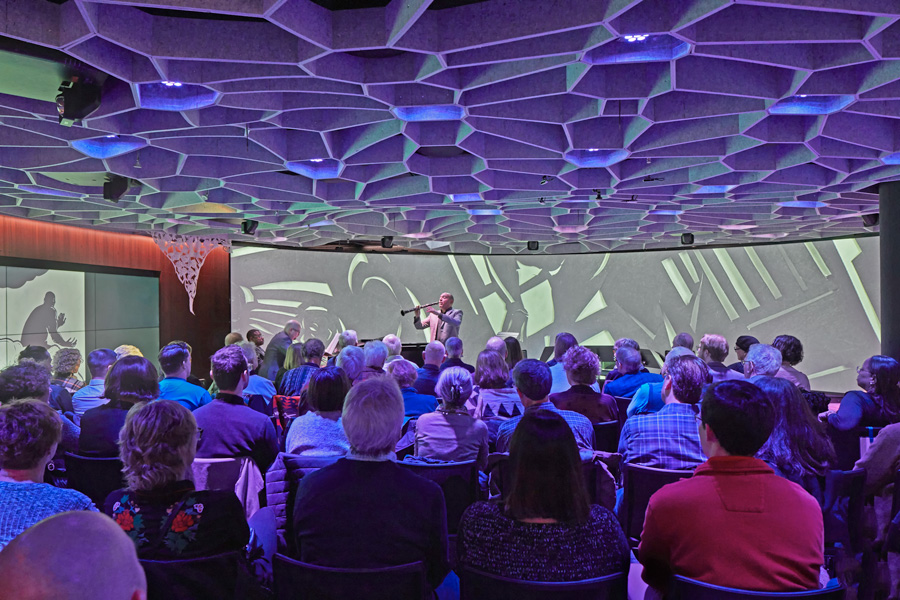Equipped with Meyer Sound’s Constellation® active acoustics and Spacemap® spatial sound, Octave 9 affords virtually limitless potential for exploring new ways to create, present and experience music from all genres and eras — from string quartets and vocal ensembles to contemporary electronic — in a richly immersive environment.
Octave 9: Raisbeck Music Center has been created by The Seattle Symphony to expand creative possibilities for musical performance and composition throughout the community. It was designed as an intimate venue inside the orchestra’s home at Benaroya Hall in downtown Seattle.
Octave 9’s street-level space had been previously occupied by Soundbridge, a modest venue primarily devoted to educational programs. It had hosted small ensemble performances, but the room’s limited size and low ceiling provided limited and fixed acoustical support. Looking to the future, Seattle Symphony Vice President of Education and Community Engagement Laura Reynolds envisioned a radical transformation using 21st century digital technologies to create highly adaptable aural and visual environments.
“We knew that if we were to transform this space into a venue that could serve many audiences, and be a place to experiment and explore, we would need the flexibility to create different acoustic environments,” Laura Reynolds recalls.
“Our project partners suggested active acoustics, and Meyer Sound was the company that immediately came to mind.”
A whole spectrum of new possibilities with refined active acoustics
For the Seattle Symphony, Octave 9 opens a spectrum of new possibilities. Reynolds shared, “When we think about the future of music, we think about partnerships with artists who are redefining experiences, intersecting with many disciplines and technologies.
For example, Constellation and Spacemap allow our resident composers and artists the opportunity to create site-specific works in new ways. They are treating the room itself as an instrument.
Beyond that, we also think of that future as inclusive of the community, so we need a space that can adapt to everything from early childhood and elementary school programs to contemporary music concerts, meetings, parties and so much more.”
Constellation is a highly refined system of active acoustics.By applying digital signal processing coupled to multiple ambient sensing microphones and an array of evenly distributed lateral and overhead loudspeakers, Constellation modifies the room’s acoustic characteristics by adding early reflections and/or reverberation to create the optimum acoustics for the event at hand.
Acoustic characteristics are generated using the patented VRAS (Variable Room Acoustical System) algorithm. As implemented at Octave 9, Constellation comprises 62 small full-range loudspeakers augmented by 10 compact subwoofers that extend the reverberation envelope through the deep bass frequencies.
Twenty-eight miniature microphones are spread across the ceiling for ambient sensing. Digital signal processing is supplied by a D-Mitri® digital audio platform with 13 modules, including two D-VRAS modules for separate control of early reflections and reverberation.
Available system presets can instantly transform room acoustics to emulate a small room, medium room, large hall or cathedral. The suite of Meyer Sound technologies also includes Spacemap, a software-based system for exploring three-dimensional spatial sound through the dynamic movement of discrete sounds around, over and through the audience.
One artist who already is leveraging the creative potential of Octave 9 is noted composer and clarinetist Derek Bermel, currently the Seattle Symphony’s composer in residence, who will debut a new work on April 28 that was written specifically to incorporate the new technologies.
“Constellation expands the dimensions of my thinking,” says Derek Bermel. “Generally, spatialization is not part of my composing palette, though I have in the past placed instrumentalists offstage, in the audience or in specific places on stage to achieve a sonic effect. But Constellation allows me to adjust the space to fit a musical concept, rather than the other way around. As you can imagine, that opens all sorts of possibilities.”
Bermel expects the late April concert will “bring the Constellation system into full effect” as it will feature works with an electroacoustic edge from a host of contemporary composers, including Seattle’s own Kaley Lane Eaton. As for his own work, he will bring the pre-recorded Seattle Symphony into Octave 9 along with live players on stage.
“I’m working with [composer and digital artist] Marcin Pączkowski to design custom spatialization that takes full advantage of the loudspeakers and microphones in the space. It’s a promising new direction, and I hope it’s the first of many creative experiences with Constellation.”
Non-stop, 24-hour music marathon introduction
Octave 9 was introduced to the Seattle music community with a non-stop, 24-hour music marathon on March 23 and 24.
Musical selection encompassed everything from multi-track electronics to solo instruments and percussion ensembles.
Composer Melody Parker, who also is the Meyer Sound acoustic engineer principally responsible for the system’s design and tuning, premiered a sound installation piece called “Hearkening” which exploited the aural dynamics of both Constellation and Spacemap.
The architecture of the space, including the innovative “honeycomb” acoustical ceiling, was designed by LMN Architects in Seattle working in collaboration with principal acoustical and AV consultant Garth Hemphill of Jaffe Holden.
For a full sensory experience, the sonic effects of Constellation are complemented by equally advanced visual technologies as designed by Belle & Wissell, Co. of Seattle. Visual effects are displayed on moveable screens that can fully surround the space with images displayed on 10 ultra-short throw projectors.
“Integrating the sonic, acoustic, and visual technologies in this room was no small feat, and is a testament to the creative vision and talents of the Seattle Symphony, Jaffe Holden, LMN, and Belle and Wissell.
Octave 9’s unique combination of adjustable active acoustics, spatial mixing, and immersive digital imagery provide a virtually unlimited palette to support both current and emerging forms of musical expression,” summarizes Meyer Sound Director, Spatial Sound Steve Ellison.
The response to Octave 9 — from critics and audiences alike — to both the marathon and the first concerts has been enthusiastic, if not ecstatic.
“At the symphony, our inboxes are filled with emails from audience members and artists who are eager to hear, see and do even more,” says Reynolds. “People love the variety of programming and the new experiences we are able to create.”
Funding for Octave 9 was raised through public and private sources, spearheaded by a $2 million matching grant from philanthropists James and Sherry Raisbeck.
More information on Meyersound technologies.










